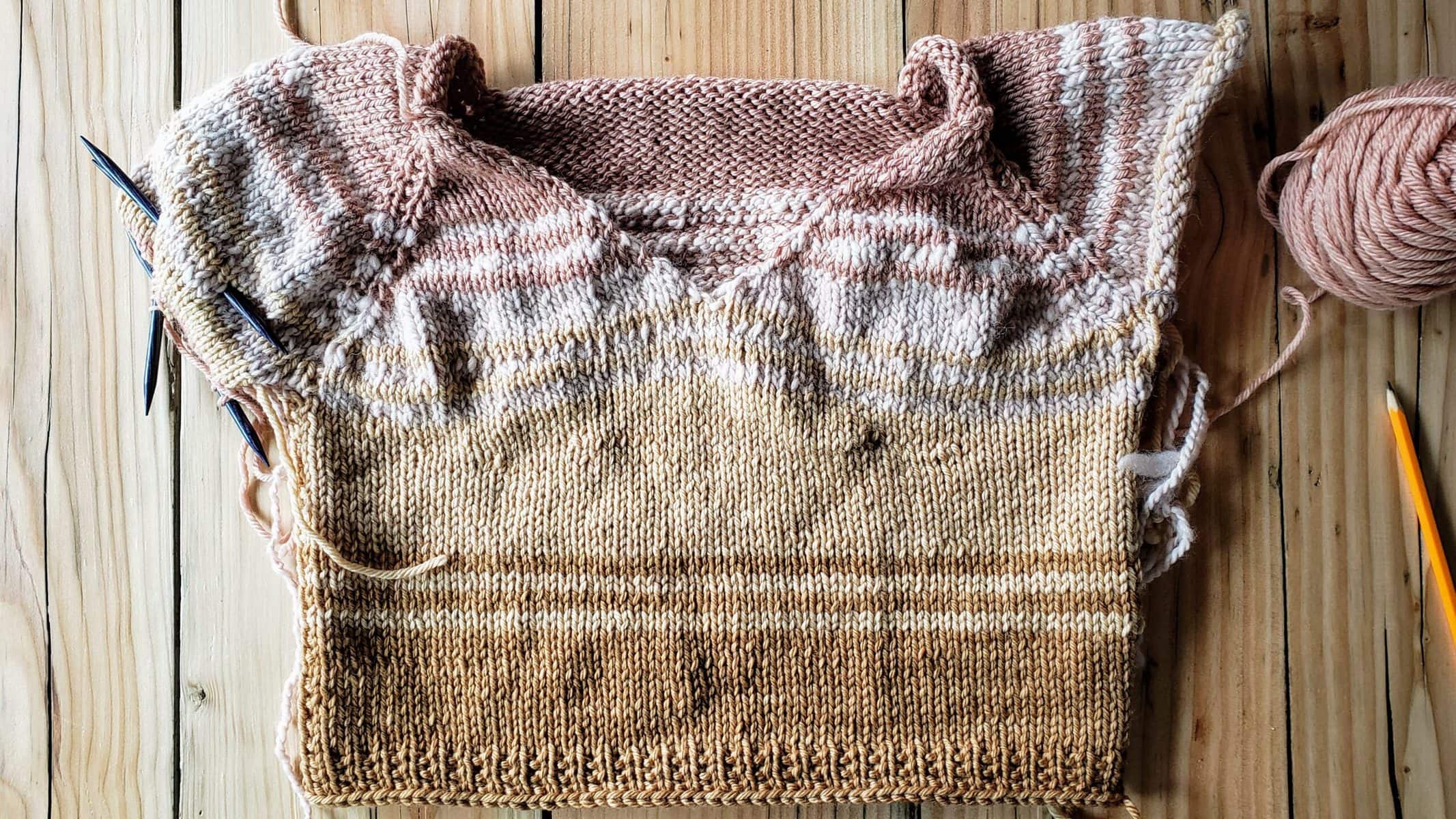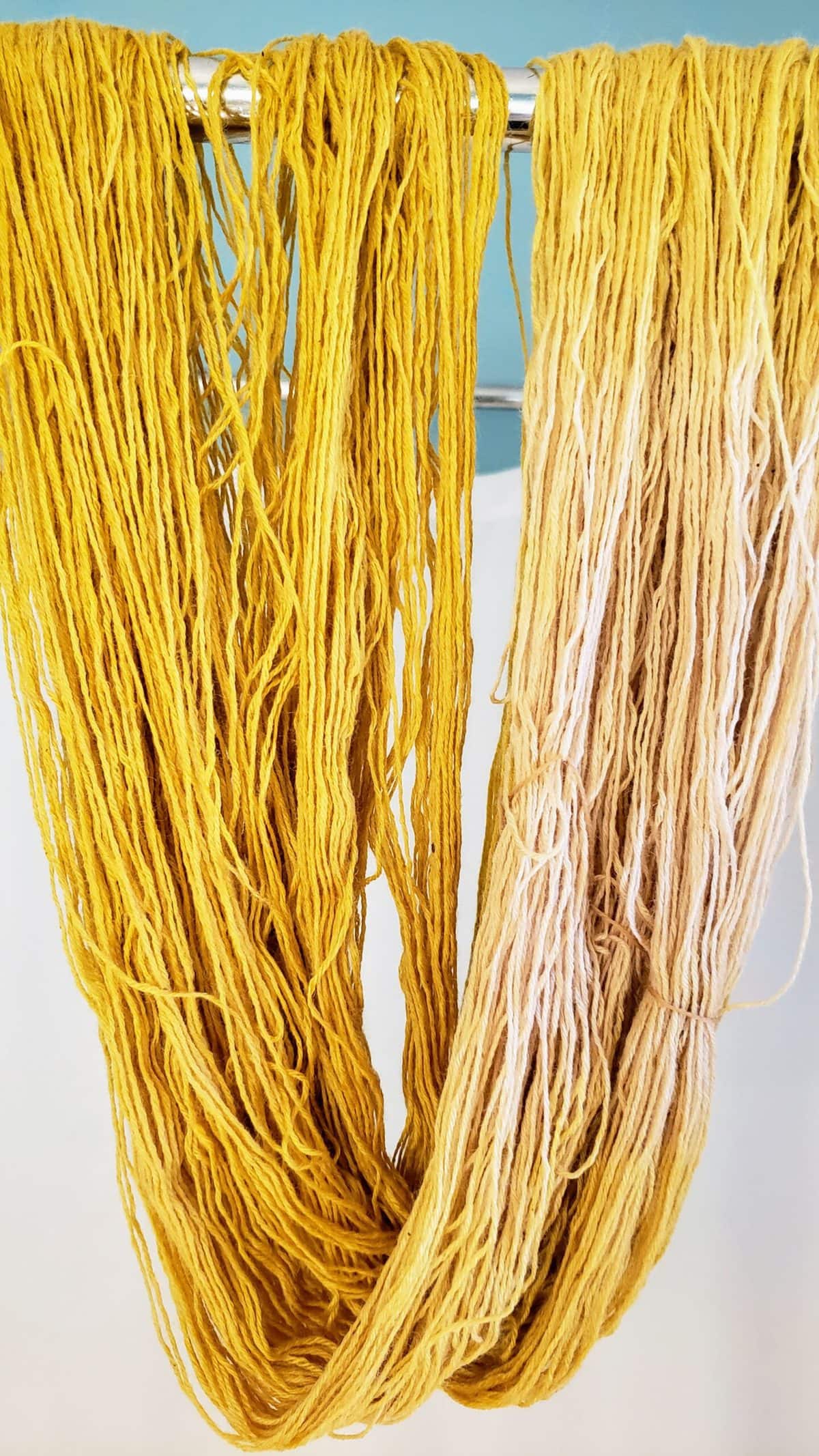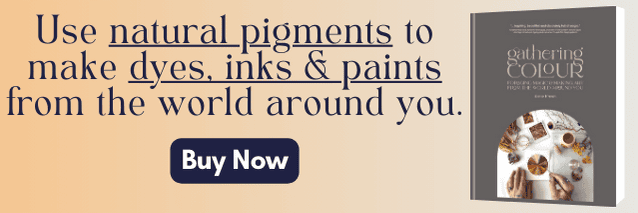After beginning this column by introducing my family’s mildly unhinged foray into hay farming, you might think my second column would pick up where we left off, after hints of dye plants and fibre-growing out at the farm. But this is a personal column, and I’m convinced that before we get to the grand plans, we have to start at the beginning of my adventures in natural dyeing.
I was certain the beginning of my natural dyeing experience was years ago, but searching for photographs for this column brought a shocker, thanks to the pandemic and its wibbly wobbly effect on time: My first time naturally dyeing anything was only nine months ago. I’d read about it before then, sure, but I didn’t actually dye anything until early 2020.


Yarn and roving dyed with avocado (pinks) and black tea (browns).
Image description: Yarn and fibre laid out on the diagonal; from bottom-left to top-right: brown yarn, tan yarn, dusty pink yarn, light pink fibre.
What tipped me over the edge from reading into doing was seeing somewhere that avocados produce peach or pink dyes. I found this so surprising and so much more exciting than playing with onion skins that I started saving pits and peels in a bag in my freezer. Eventually, I picked up some yarn blanks and spent an afternoon in my kitchen cooking up my first dye pot. It was so much fun, I raided a long-neglected cupboard and dyed some more yarn with ancient bags of black tea.
The results are in the photo here: the pinks are from the avocado; brown and tan from the tea.
What I did not do before this endeavour was fact-check information I’d gleaned from blog posts about dyeing yarn with avocado. I learned later that though avocados do contain tannins that would help to set the dye, I should have mordanted my yarn and fibre regardless. It’s quite likely the sweater I’m making from my avocado-dyed yarn will fade over time. Live and learn.


Sweater-in-progress made from avocado- and tea-dyed yarns.
Image description: Knitted striped sweater in progress, made from pink, avocado-dyed yarns, and tan or brown tea-dyed yarns.
Mordanting is a pre-dyeing process during which you prime the material so that the dye will bind to the fibres for increased light- and washfastness. One of the most commonly used mordants is alum – potassium aluminum sulfate. Having gotten the instant-gratification of tossing food scraps into a pot on my stove out of my system, my next natural dyeing afternoon was spent doing the far less exciting mordanting.
It’s the same as creating a dye pot, except instead of dye, you cook up a vat of mordant. The good part about this is that you do not need to immediately dye the material once it’s mordanted. You can let it dry, and it’ll be ready to go whenever you’re ready.


Dried and drying marigolds.
Image description: Dried orange and yellow marigold flowers in a large glass jar, through the glass of which drying flowers are visible in the distance.
So, now I was now hooked on natural dyeing, and I was eager to free myself from the bounds of kitchen scraps. As soon as the weather started warming up in the spring, I donned a mask and bought a couple of flats of marigolds at the local garden centre. These I potted around our small backyard, with plans to harvest the flowers, dry them, and use them to do more dyeing.
Through the spring and summer, I tended to the flowers, picking them when they were about to start to droop, and laying them out to dry on a countertop. By the end of the season I’d filled a large mason jar with dried flowers, and I felt exceptionally proud of myself.
Of course, best laid plans and all that.
One Friday in early October our fridge died. Indeed, we’re pretty sure it had died quietly the day before, which is why the contents of the freezer were mostly thawed when we discovered it. Adding insult to injury, the ice cream was warm soup and we were robbed of the need to consume it all at ten in the morning.
As we dealt with the mess and the stress of requiring appliance repair during a pandemic-related supply-chain breakdown, I discovered the bag of avocado pits and peels I’d again been saving. Determined to salvage at least this one small thing, I tossed them into a pot on the stove. The lemonade I would make out of the sour reality that refrigerators are manufactured to last an appallingly short time would be more lovely pink yarn.
Alas, no. Whether it was something to do with the thawed dyestuffs or a failure to regulate the temperature of the dye pot, what resulted was the most uninspired beige I could have anticipated. Instead of lemonade, I got lemon juice poured right into my cuts. (Not many people would accept such a dramatic reaction to beige, but you, dear reader, are a fellow creative. You know.)


*Sad trombone*
Image description: Beige-coloured yarn in a metal bowl, looking quite a lot like pasta.
But yes, you’re right! I know you’re thinking what I was thinking: the marigolds. The marigolds!
I could overdye the sad beige with marigolds.
And a few days later, that is exactly what I did. (I learned from helpful folks on Instagram that I would not need to re-mordant the beige yarn. Once mordanted, always mordanted.)


Marigolds in the dye pot.
Image description: Large pot filled with water, with marigold flowers soaking at the top.
Dipping the yarn into the marigold dye shows how quickly the dye takes hold. Fun!
Video description: 15 seconds showing a hank of beige yarn being dipped into the dye pot then removed, showing it has turned yellow.


Hank of yarn drying (over a shower-curtain rod).
Image description: Hank of yarn hanging from a rod; most of the hank is yellow and a small section is beige.
As you can see above, wowza, did the marigolds create a rich, deep yellow. I kept a bit of each skein out of the dyepot to preserve the sad beige. It felt important not to erase it entirely.
I also feel like this yarn isn’t done yet. Not only because I don’t like how it looks yet, I also feel like I’m not done learning with it. My next experiment with my dye pot will be to dip part of these skeins into an iron modifier.
And that’s what will take us back to the hay farm, because the iron modifier I’ll use is from rusted bits of metal I picked up around the farm last summer.
See, all roads in this column will come back to the hay farm in one way or another. Stay tuned!




